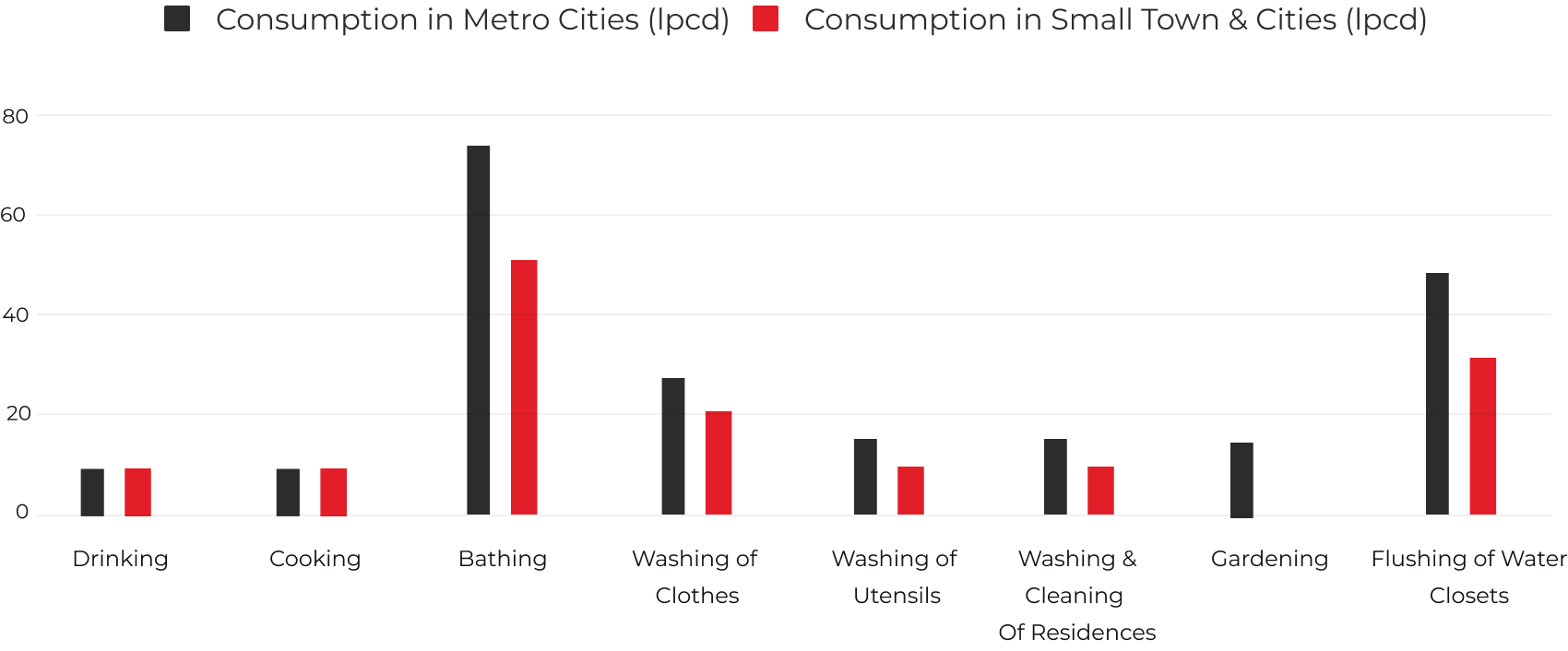
Water is a necessary element for all forms of living beings. It serves various purposes to satisfy their needs like domestic purposes which include drinking, cleaning, cooking etc., and industrial purposes like processing, fabricating, manufacturing etc. To do that, every sector demands a certain quantity of water every year in some percentages. This is called water demand and it varies from sector to sector.
To meet this demand, water is withdrawn from a source (surface and sub-surface) and transported to the desired location. This amount of withdrawn water is called water intake. The unrequired or excess amount of water is let out back into the reservoir and is called water discharge. If the amount of water discharge is deducted from water intake, the remaining amount is called water consumption i.e. the amount of water used to complete a certain purpose. The water consumption is calculated based on sectors viz. domestic and non-domestic. Domestic consumption includes drinking, cooking, cleaning and other household functions whereas non-domestic consumption includes irrigation, industries, commercial establishments, mining, livestock, etc.


In India, the domestic water consumption is about 135 litres per capita per day (lpcd) for the urban regions and 75 lpcd for the rural regions which accounts for 4% of the water footprint. About 30% of the country’s population is supplied with safe drinking water, though with limited supplies. The amount of domestic water consumption per person varies as per the living conditions of the consumers. Around 50% - 60% of the total water consumption is accounted for the domestic water consumption.

The chart above briefs about the minimum domestic consumption of water in metro cities and small towns of India as per IS 1172-1993.
Moving on to the non-domestic consumption, it consists of 4 sectors viz. industrial, institutional and commercial, public uses, and fire demand. Among these, the industrial sector is said to have maximum water demand nationally as well as globally. According to CPCB, almost 8% of the total available water in the country, while the world bank stated that the total freshwater withdrawal is about 13%. As the years pass by, due to haphazard urbanization, the water demand in the industrial and energy sector is increasing at a rate of 4.2% per year. As for the institutional and commercial sectors which include hospitals, schools and colleges, restaurants, offices, railway stations, etc., the average per capita demand is around 20 lpcd. This demand may increase to 50 lpcd for highly commercialized cities. The following chart and approximate water demand of certain industries.
Table: Average Water Consumption of Different Institutions & Commercial Establishments
| S.No. | Type of Institution or Commercial Establishment | Average Water Consumption (litres/head/day) |
|---|---|---|
| 1 | Offices | 45-90 |
| 2 | Factories | |
| A) Bathrooms provided | 45-90 | |
| B) No bathrooms provided | 30-60 | |
| 3 | Schools | |
| A) Day Scholar | 45-90 | |
| B) Residential | 135-225 | |
| 4 | Hostels | 135-180 |
| 5 | Hotels | 180 (per head) |
| 6 | Restaurants | 70 (per seat) |
| 7 | Hospitals (including laundry) | 70 (per seat) |
| A) No. of beds not exceeding 100 | 340 (per bed) | |
| B) No. of beds exceeding 100 | 450 (per bed) | |
| 8 | Nurse homes and medical quarters | 135-225 |
| 9 | Railway Stations | |
| A) Junction and intermediate stations where mail and express trains stop | 70 (with bathing facility) 45 (without bathing facility) |
|
| B) Intermediate stations where mail and express trains do not stop | 45 (with bathing facility) 23 (without bathing facility) |
|
| C) Terminal railway stations | 45 | |
| 10 | Airports - International and domestic | 70 |
| 11 | Cinema halls and theatres (per seat) | 15 |
When considering the water demand for public uses, on an arbitrary basis, the nominal amount is always 5% or below. The value can be taken as 10 litres/head/day. This amount of water is used for public utility purposes like gardening, washing and sprinkling on roads, etc.
Moving on to the fire demand of the country, densely populated and industrial areas are bound to experience fire outbreaks and hence have firefighter squadrons for backup. These squadrons require an ample amount of water to put out the fire as it is thrown towards it at a higher speed and should be readily available and stored in reservoirs. For this, the minimum water pressure required is 100-150 kN/m3 and should be maintained even after continuous use of 4-5 hours with a discharge of about 1100 litres/minute. Hence, the amount of water depends on the population.
This sums up the various sectors in India and their respective water consumption. The industrial sector to date dominates all the consumption charts. With a growth rate of 4.2% per year as discussed in the article, the water demand for the industrial sector is negligible and bound to grow near 228 billion cubic meters by the year 2025. With increasing water demand, the treatment of the wastewater that is let into the reservoirs is necessary, yet 70% of it is dumped without any treatment. Segregation of wastewater into clean water and contaminated water is a must else, the consequences might be as horrific as having no good and pure water for consumption.